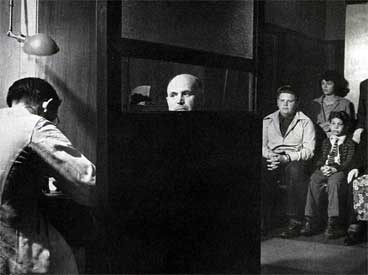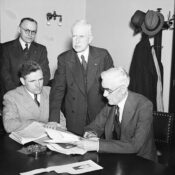In the long battle against the rise of socialized medicine in this country, the burden of defense has been carried by the American Medical Association and its fast-talking editor, Dr. Morris Fishbein, who has a beat-’em-down technique in debate. In spite of Doctor Fishbein’s dynamic delivery, the AMA has often defended the status quo instead of actively seeking an alternative solution. The organization has in the past opposed or given a cool reception to almost every development designed to solve the problem of the distribution and cost of medical care—including many which have turned out to be beneficial. Hospital- and medical-care insurance plans struggled through their early growth without the benefit of the AMA blessing. Group practice, in which a partnership or team of general practitioners and specialists provide complete medical care, was not given general encouragement, on the ground that some groups were tainted with commercialism.
Much of this conservatism in medical economics is understandable in a profession which must safeguard the public from premature and immature “cures,” and which must handle new treatments and drugs with caution until they have been proved safe and effective. But it has often worked to the profession’s disadvantage. Plainspoken Dr. Paul R. Hawley, who overhauled the Veterans Administration medical department a few years ago and who now heads the Blue Cross Blue Shield Commission, summed up the reaction of more liberal physicians to this static defense in a recent speech: “I am afraid that a large part of the public has come to expect organized medicine to oppose every suggestion tending to solve this problem of the cost of medical care.”
Now, however, organized medicine is at last definitely pushing voluntary health insurance as the best defense against the compulsory Government directed variety and as an answer to a real need. In a refreshingly frank editorial, the Journal of the American Medical Association recently stated: “No one asserts or claims that leadership in American medicine has not on occasion made mistakes. … No one claims even that the House of Delegates (representative governing body of the AMA) has not on occasion been slow to change its point of view. But medical leadership does claim that physicians must have evidence of the desirability of new methods and new technics in the delivery of medical service before it can act for the medical profession of the nation in accepting any proposal. Indeed, the great hazard of such legislation as that which perpetrated the National Health Act on the people of Great Britain is the difficulty of eliminating such a procedure even after its faults have become horribly obvious.”
To carry its arguments to the entire population, through speeches, posters, movies, and millions of pamphlets, the AMA is now raising a “war chest” of about $3.5 million through a $25-per-member assessment. (There are 140,000 members.) The AMA’s new “battle plan,” prepared with the help of its newly retained Chicago public-relations consultants, Clem Whitaker and Miss Leone Baxter, urges organized medicine to “get off the defensive” and to “conduct an affirmative program of education,” including “active cooperation with the prepaid medical and hospital plans and the accident and health insurance companies, in an all-out drive to provide the American people with voluntary-health insurance coverage.”
Most of the AMA’s state societies, during the past several years, have established their own prepayment medical-care programs. These Blue Shield plans, as they are called, are now operating in 42 states and the District of Columbia, and cover a total of about 10 million subscribers and dependents. Annual premiums range from $25 to $50 per family, and the plans pay for surgical and often for medical care, in cases requiring hospitalization. They are usually sold by the Blue Cross hospital-insurance organizations, which now have a total enrollment of about 31 million.
Advocates of compulsory health insurance object that the voluntary surgical and medical insurance plans cover only the hospitalized cases and do not pay for home and office calls. This is true in most plans. But medical bills incurred during hospital illness make up half the nation’s outlay for medical care and, for most families, it is the tough half because it comes unexpectedly and in big chunks. It is these big bills that wreck the family budget, but it is the oft-repeated small bills for office and home calls that can wreck either voluntary or compulsory insurance schemes. The reason for this is that when payment of a fixed annual fee entitles people to call the doctor as many times as they wish, the system is abused. The insurance company, paying the doctor for each visit, finds its funds drawn on too heavily. The home and office calls, without restriction on number, are not, in other words, a predictable and, therefore, an insurable risk. The Michigan Medical Service, one of the first state-society plans, started to cover these calls under its annual premium, but almost went broke and had to write in restrictions.
A second important objection to voluntary health insurance is that the poorer people cannot afford the premiums and therefore are not covered. Dr. Gilson Colby Engel, a Philadelphia surgeon and president of the Medical Society of Pennsylvania, recently proposed a plan which would correct this deficiency and which has now become a key feature of the bill introduced by Sen. Lister Hill, Democrat, of Alabama. Membership cards in voluntary hospital and health-insurance organizations would be issued to those certified by local welfare authorities as requiring financial assistance. The cards would be identical with those carried by full paying subscribers, and this would avoid the embarrassment of the “means test” at the hospital at the time the individual was admitted. Federal and state funds would then be used to reimburse the voluntary-health-insurance organizations for the bills incurred during the hospitalized illness. At the suggestion of Dr. Paul Magnuson, chief medical director of the Veterans Administration, the Hill bill would provide diagnostic centers to serve the entire population, again through voluntary-insurance organizations and with state and Federal financial support.
Sen. Lister Hill, author of the measure, has long been interested in medical affairs. He is named after the famous English surgeon, Lord Lister, with whom his father, the late Dr. Luther L. Hill, of Montgomery, Alabama, studied as a young man. Senators Hill and Harold Burton, of Ohio (now a Supreme Court justice), sponsored the Hill Burton Hospital Survey and Construction Act, to provide Federal grants for hospitals throughout the country. More than 700 projects have been approved. Hill’s four cosponsors on the present health bill are Senators George D. Aiken, of Vermont; Garrett L. Withers, of Kentucky; Wayne Morse, of Oregon; and Herbert R. O’Conor, of Maryland. All but Mr. O’Conor are members of the Senate Committee on Labor and Public Welfare, which will consider this bill, the Administration measure and the new health bill introduced by Sen. Robert Taft. The Taft bill would establish a National Health Agency to be headed by a doctor and to take in the Public Health Service, the Food and Drug Administration, and other health functions now performed by Ewing’s Federal Security Administration. It would also make grants to the states for assisting in the payment of medical care costs for those unable to pay their own, in a manner somewhat similar to that proposed in the Hill bill. Taft’s cosponsors are Senators H. Alexander Smith, of New Jersey, and Forrest C. Donnell, of Missouri. All three are on the Labor and Public Welfare Committee, seven of whose thirteen members are thus sponsoring voluntary rather than compulsory health insurance measures.
This, then, is where we stand today. The lines are more sharply drawn than ever before. Politically powerful groups in the Administration and in Congress are determined to push Government medicine through. An equally determined medical profession, without whose co-operation any plan would be sure to strike heavy going, plus millions of laymen opposed to the idea of the handout state, are on the opposite side. You are being asked to decide whether you want Government-directed medical care, paid for by compulsory contributions and by taxes, or whether you will reject it as a glittering package that will dilute the quality of medical care, stifle the doctors’ initiative and nick your purse for unpredictably large amounts. Your decision, in the light of the experiences in Britain and other countries, will profoundly affect your welfare for years to come.
Become a Saturday Evening Post member and enjoy unlimited access. Subscribe now




Comments
Thanks for the article.
Here’s my comment – really just a couple of questions;
I’m wondering if, aside from England where the new system is in it’s infancy, there are any other countries with national health care systems of longer standing. It’s be interesting to me to see how they’ve made out & how they’ve worked out the kinks and what things have yet to be worked out.
And what part do the interests of insurance companies play, everyone knows that money is a big player in the way things are decided in Washington.
That’s it